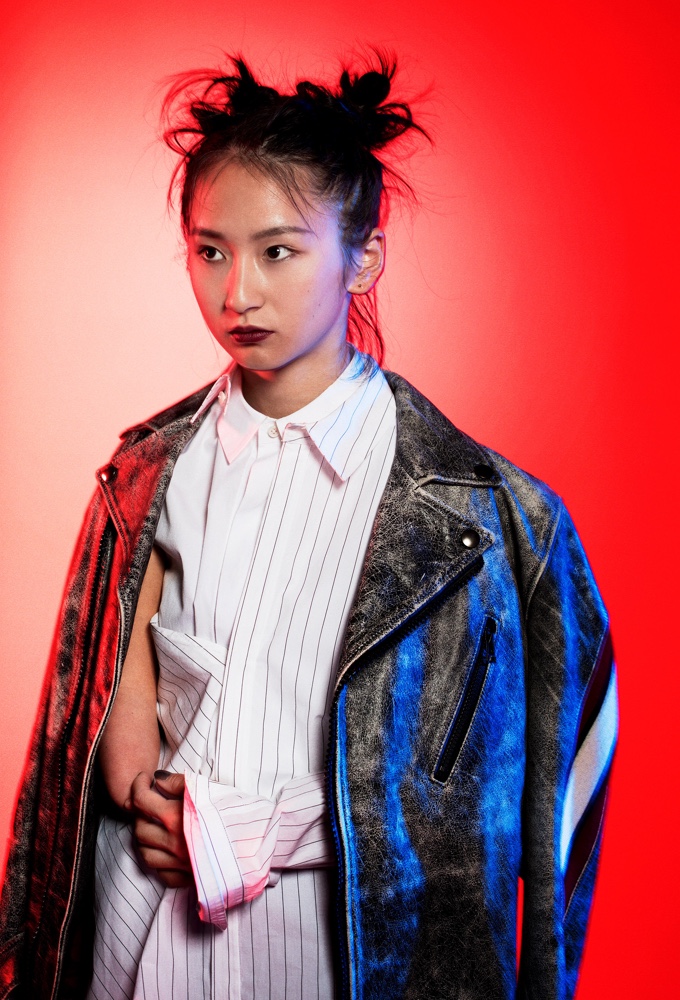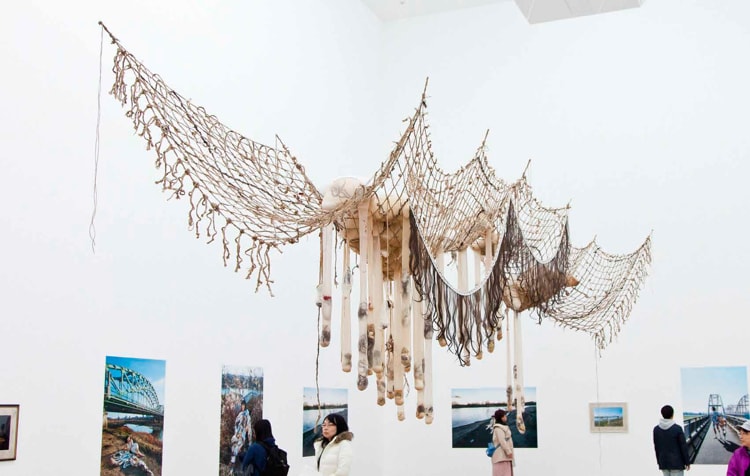
Mari KATAYAMA
Mari KATAYAMA | ARTIST
Photographs by Yusuke YAMATANI Text by Yumiko SAKUMA
- Living Well Is Beautiful
- The “Artificial” and the “Natural” Encountered in Daily Life
When I did a Google search for “Mari Katayama” in Japanese, the words “an artist with prosthetic legs” instantly caught my
eye. When I searched for her images, I found her self-portraits and was met with a piercing gaze. I was impressed
by her TED talk, where she calmly and straightforwardly described her childhood experiences of being bullied.
I always do research on an interviewee before doing an interview. In this instance, words such as “prosthetics” and “bullying” inevitably popped into my head. Having faced physical challenges which are unknown to the large majority of us, she has been wearing prosthetic legs for a long time. What is more, she experienced being bullied because of that. And now, she is an artist.
When I was offered the job to interview Mari Katayama, I immediately thought, I want to meet her! I wanted to know how she found art and her own style of expression. Learn how she got through difficult times and reached her own path. See how she perceives today’s world.
I always do research on an interviewee before doing an interview. In this instance, words such as “prosthetics” and “bullying” inevitably popped into my head. Having faced physical challenges which are unknown to the large majority of us, she has been wearing prosthetic legs for a long time. What is more, she experienced being bullied because of that. And now, she is an artist.
When I was offered the job to interview Mari Katayama, I immediately thought, I want to meet her! I wanted to know how she found art and her own style of expression. Learn how she got through difficult times and reached her own path. See how she perceives today’s world.
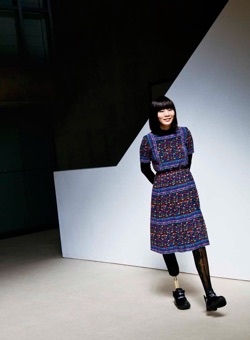
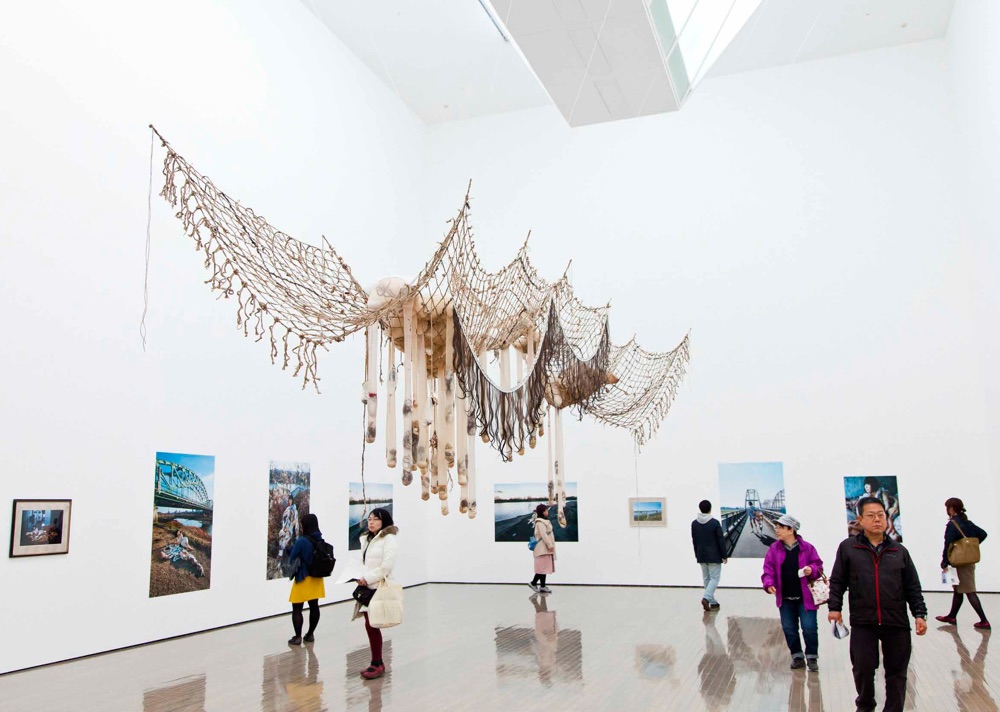
“If you don’t have it, make it.”
I met Katayama in March this year, on the last day of her solo exhibition entitled “On the Way Home.” She was at
the entrance of the Museum of Modern Art in Gunma, to greet me when I arrived. I was astounded by her strong
presence. It was partly because of her height—she is 180 cm tall (5’11”) on her prosthetics—but I think it was
also because she emanated such powerful energy. She was six months pregnant at the time and expecting a baby
in a few months.
We briefly exchanged greetings and proceeded to her exhibition on the second floor. Katayama, who grew up in Ota, Gunma Prefecture, launched her career as an artist after winning an award in The 8th Gunma Biennale for Young Artists ’05 when she was still in high school. The solo exhibition, being shown in the same museum as that Biennale, consisted of photographs she took while driving to and from university as a student, along with photographs that she took after moving back to Gunma from Tokyo two years ago.
“Gunma Prefecture is really, really flat and spacious, with lines of telephone poles dotting the landscape. I used to imagine that it was what the United States must look like. I saw it like the small town where the character, played by Keanu Reeves; lived in the movie River’s Edge, and I was proud to be living in Gunma [laughs]. I still feel that way even after coming back here to live.”
Some people consider Katayama’s works as self-portraits. Here, at the exhibition, I thought that word did not capture their essence. It was true that they were photographs that she took of herself, but there are many elements included in the shots, with each element having significance.
“My first creations were art objects. I would place them on my body, take photographs, and show them online instead of providing explanations. That was what sparked things. There was a photographer who heard about me and asked to take photos. The problem with that is, even if it was space that I’d created with things that I’d made, it became somebody else’s work of art the moment someone other than me took that photo. So, I decided to take the photographs myself using a cheap tripod and self-timer.”
The final output may be in the form of photographs, but her home—the space that she produces—is also a part of her artwork. The cushions made in the shape of her hands and legs, the decorations of pearls, shells and Swarovski crystals, the collages duplicated in the stickers, the objects of jars filled with leftover materials “pickled” in salad oil—everything was made by her hand work.
“Many of the materials I use are from daily life. They’re things closely related to everyday living.”
When we got to the large installation hanging from the ceiling, Katayama said, “There’s a saying in Spain that living well is the best revenge.”
“It’s not that I’m out to get revenge on someone. I believe that in the end, living as well as one can is best. But that’s something that’s possible only through the repetition of daily life.”
Katayama mentioned more than once that she still does not know what art is. For her, “the mundane” and “daily life” are important themes. My impression is that this kind of thinking is possible only to those who have overcome unimaginable struggles and attained a state of mind in which utmost beauty is found in the gradual passage of time.
We briefly exchanged greetings and proceeded to her exhibition on the second floor. Katayama, who grew up in Ota, Gunma Prefecture, launched her career as an artist after winning an award in The 8th Gunma Biennale for Young Artists ’05 when she was still in high school. The solo exhibition, being shown in the same museum as that Biennale, consisted of photographs she took while driving to and from university as a student, along with photographs that she took after moving back to Gunma from Tokyo two years ago.
“Gunma Prefecture is really, really flat and spacious, with lines of telephone poles dotting the landscape. I used to imagine that it was what the United States must look like. I saw it like the small town where the character, played by Keanu Reeves; lived in the movie River’s Edge, and I was proud to be living in Gunma [laughs]. I still feel that way even after coming back here to live.”
Some people consider Katayama’s works as self-portraits. Here, at the exhibition, I thought that word did not capture their essence. It was true that they were photographs that she took of herself, but there are many elements included in the shots, with each element having significance.
“My first creations were art objects. I would place them on my body, take photographs, and show them online instead of providing explanations. That was what sparked things. There was a photographer who heard about me and asked to take photos. The problem with that is, even if it was space that I’d created with things that I’d made, it became somebody else’s work of art the moment someone other than me took that photo. So, I decided to take the photographs myself using a cheap tripod and self-timer.”
The final output may be in the form of photographs, but her home—the space that she produces—is also a part of her artwork. The cushions made in the shape of her hands and legs, the decorations of pearls, shells and Swarovski crystals, the collages duplicated in the stickers, the objects of jars filled with leftover materials “pickled” in salad oil—everything was made by her hand work.
“Many of the materials I use are from daily life. They’re things closely related to everyday living.”
When we got to the large installation hanging from the ceiling, Katayama said, “There’s a saying in Spain that living well is the best revenge.”
“It’s not that I’m out to get revenge on someone. I believe that in the end, living as well as one can is best. But that’s something that’s possible only through the repetition of daily life.”
Katayama mentioned more than once that she still does not know what art is. For her, “the mundane” and “daily life” are important themes. My impression is that this kind of thinking is possible only to those who have overcome unimaginable struggles and attained a state of mind in which utmost beauty is found in the gradual passage of time.
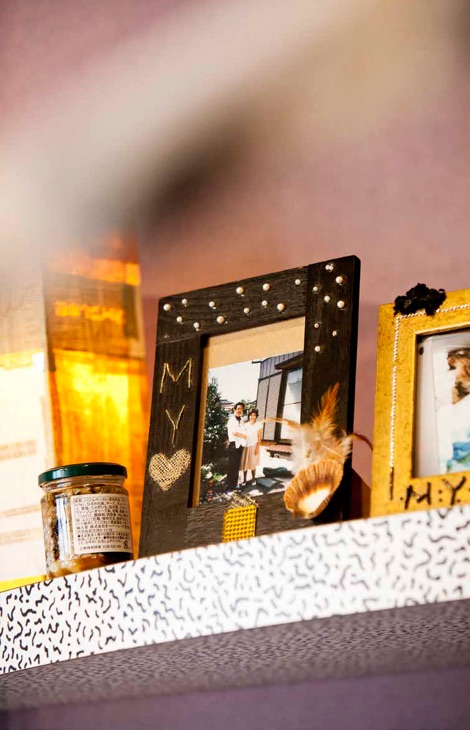
Mari Katayama, artist. Raised in Ota, Gunma Prefecture. Born with tibial hemimelia in which the shin bone is
missing. Also has a cleft left hand with only two fingers.
“Before the amputations, I wore boots-like leg braces. I couldn’t wear regular children’s clothes wearing them. Our family motto was, “If you don’t have it, make it.” My mother was a single parent, and we were in financially tight circumstances. We only bought what was really needed, and my mother and grandmother recycled and remade old clothes for me.”
Katayama chose amputation when she was nine years old, marking the beginning of her life with prosthetic legs. She spent more time at home, playing by herself. She also got into reading manga and drawing pictures. Under her mother’s and grandmother’s influence, the first tools she started working with were needle and thread. Since her mother used to be a fashion model, she was attracted by the world of fashion and began drawing designs on her prosthetic legs.
“I started remaking my own clothes when I was in junior high school, but apparently, I had really bad taste! They were not stylish at all! [laughs] I still feel awe toward fashion.”
As a single parent who raised Katayama working as a hairdresser, Katayama’s mother wanted a stable, secure life for her daughter.
“She advised me, “You’re not physically capable of earning a living by doing manual labor. You should acquire a vocational skill so that you can live a stable life.” I was thinking of working as a company employee, too.”
“Before the amputations, I wore boots-like leg braces. I couldn’t wear regular children’s clothes wearing them. Our family motto was, “If you don’t have it, make it.” My mother was a single parent, and we were in financially tight circumstances. We only bought what was really needed, and my mother and grandmother recycled and remade old clothes for me.”
Katayama chose amputation when she was nine years old, marking the beginning of her life with prosthetic legs. She spent more time at home, playing by herself. She also got into reading manga and drawing pictures. Under her mother’s and grandmother’s influence, the first tools she started working with were needle and thread. Since her mother used to be a fashion model, she was attracted by the world of fashion and began drawing designs on her prosthetic legs.
“I started remaking my own clothes when I was in junior high school, but apparently, I had really bad taste! They were not stylish at all! [laughs] I still feel awe toward fashion.”
As a single parent who raised Katayama working as a hairdresser, Katayama’s mother wanted a stable, secure life for her daughter.
“She advised me, “You’re not physically capable of earning a living by doing manual labor. You should acquire a vocational skill so that you can live a stable life.” I was thinking of working as a company employee, too.”
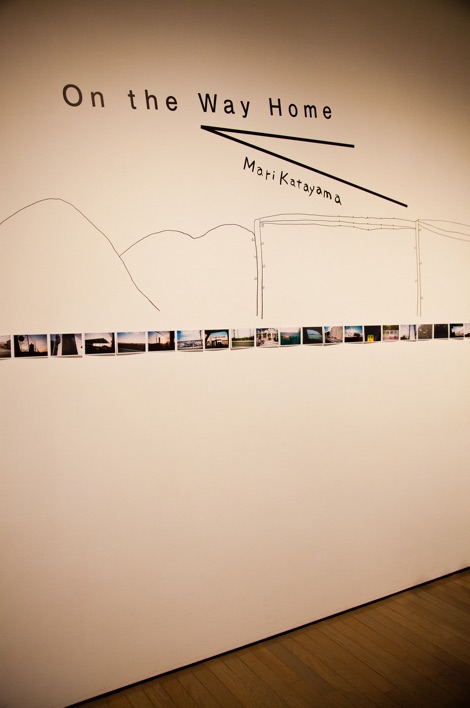
The turning point came when she was studying at a commercial high school where she had enrolled on her way to
becoming an accountant. Katayama was not very good at writing essays, which would be required for finding employment.
Her teacher suggested, “Why not write about the drawings on your prosthetic legs?”
“That teacher also happened to be the advisor for the high school art club and submitted the essay I’d written to the Gunma Biennale for Young Artists.”
The initial screening for the Biennale was based on essays that explained the concept of a work. The secondary screening was on the completed work itself. Katayama said, “The work I submitted for the secondary screening wasn’t much, but my essay won recognition, and I passed the screening.” This was how she debuted as an artist.
“Unlike other schools, there were no art classes in my school. I liked drawing, but I started my artistic activities without really understanding what art was.”
It was around the same time that she had another important encounter. Before winning an award in the Biennale, she met a stylist Tatsuya Shimada on the Myspace social networking website. At the time, Shimada was a student of the Vantan Design Institute, and he asked Katayama to model for him.
“I was crazy for fashion, so I was really happy to be asked. I wouldn’t be where I am today if I hadn’t met Mr. Shimada.”
“That teacher also happened to be the advisor for the high school art club and submitted the essay I’d written to the Gunma Biennale for Young Artists.”
The initial screening for the Biennale was based on essays that explained the concept of a work. The secondary screening was on the completed work itself. Katayama said, “The work I submitted for the secondary screening wasn’t much, but my essay won recognition, and I passed the screening.” This was how she debuted as an artist.
“Unlike other schools, there were no art classes in my school. I liked drawing, but I started my artistic activities without really understanding what art was.”
It was around the same time that she had another important encounter. Before winning an award in the Biennale, she met a stylist Tatsuya Shimada on the Myspace social networking website. At the time, Shimada was a student of the Vantan Design Institute, and he asked Katayama to model for him.
“I was crazy for fashion, so I was really happy to be asked. I wouldn’t be where I am today if I hadn’t met Mr. Shimada.”
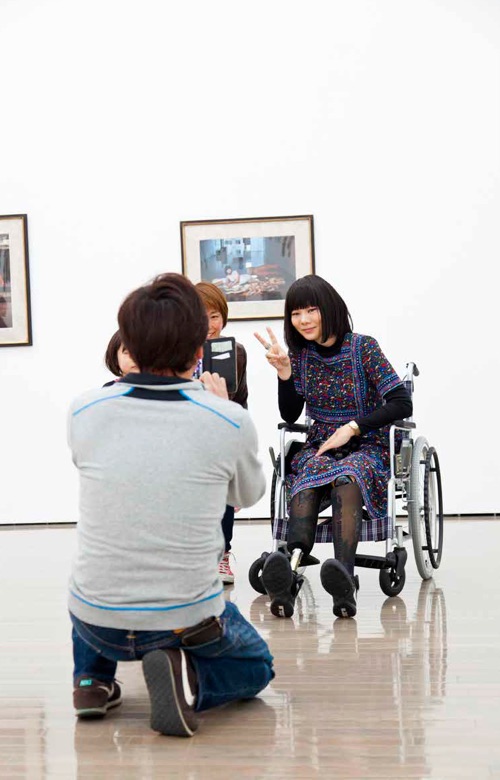
Even after she received recognition for her style of expression, Katayama did not plan to become a full-time artist.
However, meeting the late Takashi Azumaya, who was an independent curator and served as a judge for the Gunma
Biennale for Young Artists, gave her another push in that direction.
“I had already started creating my works by that time, but I couldn’t show them to anyone. I couldn’t even explain to myself or understand what the creations were. I needed someone like him who was supportive to me by saying, “keep going” as a response to my enormous enthusiasm to create anyway, and let me continue on my way.”
With encouragement from Mr. Azumaya, Katayama went on to the Master of Fine Arts program at Tokyo University of the Arts. There, she took photography classes at the suggestion of her professor, Motohiko Odani. She also began musical activities while in school.
“I tried to find a part-time job to help pay my tuition, but I was refused every time. I thought, Why??? I eventually thought that I had no choice but to work as a hostess, and knocked on the door of a hostess bar. The bar manager decided to let me to sing on stage because I reminded him of his deceased wife. When I sang, I was ridiculously off key but it became something distinctive. One thing led to another, and before I knew it, I was carrying out activities as a musician.”
Even as a student, Katayama had opportunities to engage in self-expressive activities in these ways, however, she still did not consider making a living as an artist.
“I just couldn’t keep up with the high level of artistic awareness held by other students at Tokyo University of the Arts. Even after graduating, I continued trying to land an office job, making visits to the employment center in search of a job. I was looking for a company equipped with an elevator and western-style toilets [laughs]. But nobody was interested in hiring me. Ironically, the only offers that I got were those related to art.”
Katayama said that she was still job hunting even after participating in Aichi Triennale 2013. It seems, however, that she has finally accepted that she is going to live as a fulltime artist carrying out self-expressive activities. I asked her about art as a form of communication.
“I think I’m suited for it in that it’s an unobtrusive, unconfined and freewheeling communication style. For example, some people who see my work say it looks sad or lonely. I didn’t make the pieces to express those things, but people project their own emotions on them, and see that kind of thing in them. Now I see, in a sense, I’m at the point where I now think that, in a sense, is communication, too.”
It was the words of Kazue Kobata, her mentor at Tokyo University of the Arts and a translator of Susan Sontag’s works, that triggered this way of thinking.
“She advised me, ‘Just make sure to read books. Then, you can become ‘friends’ with people who lived one or two hundred years ago.’ I can now take pride as having the chance to become one such person through my self-expressive activities. I’m not good at direct communication with people, so I think this form of communication agrees with me.”
“I had already started creating my works by that time, but I couldn’t show them to anyone. I couldn’t even explain to myself or understand what the creations were. I needed someone like him who was supportive to me by saying, “keep going” as a response to my enormous enthusiasm to create anyway, and let me continue on my way.”
With encouragement from Mr. Azumaya, Katayama went on to the Master of Fine Arts program at Tokyo University of the Arts. There, she took photography classes at the suggestion of her professor, Motohiko Odani. She also began musical activities while in school.
“I tried to find a part-time job to help pay my tuition, but I was refused every time. I thought, Why??? I eventually thought that I had no choice but to work as a hostess, and knocked on the door of a hostess bar. The bar manager decided to let me to sing on stage because I reminded him of his deceased wife. When I sang, I was ridiculously off key but it became something distinctive. One thing led to another, and before I knew it, I was carrying out activities as a musician.”
Even as a student, Katayama had opportunities to engage in self-expressive activities in these ways, however, she still did not consider making a living as an artist.
“I just couldn’t keep up with the high level of artistic awareness held by other students at Tokyo University of the Arts. Even after graduating, I continued trying to land an office job, making visits to the employment center in search of a job. I was looking for a company equipped with an elevator and western-style toilets [laughs]. But nobody was interested in hiring me. Ironically, the only offers that I got were those related to art.”
Katayama said that she was still job hunting even after participating in Aichi Triennale 2013. It seems, however, that she has finally accepted that she is going to live as a fulltime artist carrying out self-expressive activities. I asked her about art as a form of communication.
“I think I’m suited for it in that it’s an unobtrusive, unconfined and freewheeling communication style. For example, some people who see my work say it looks sad or lonely. I didn’t make the pieces to express those things, but people project their own emotions on them, and see that kind of thing in them. Now I see, in a sense, I’m at the point where I now think that, in a sense, is communication, too.”
It was the words of Kazue Kobata, her mentor at Tokyo University of the Arts and a translator of Susan Sontag’s works, that triggered this way of thinking.
“She advised me, ‘Just make sure to read books. Then, you can become ‘friends’ with people who lived one or two hundred years ago.’ I can now take pride as having the chance to become one such person through my self-expressive activities. I’m not good at direct communication with people, so I think this form of communication agrees with me.”
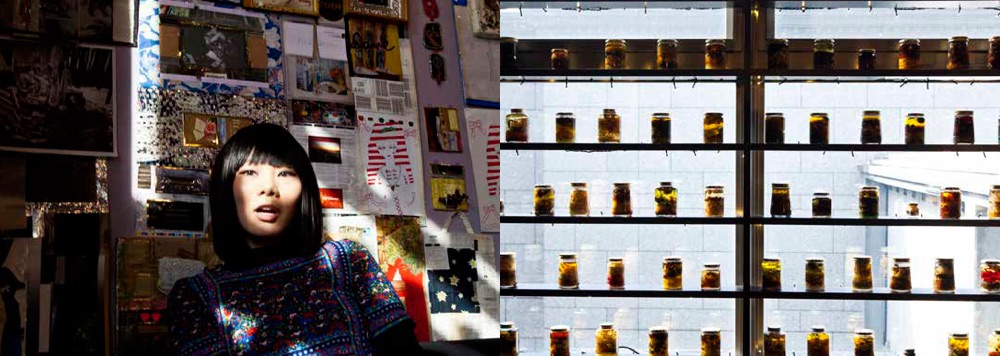
Talking with her like this, I got no sense that she was unskilled in direct communication with people. In fact,
just listening to her drew me to her. It made me think that she is a born expressionist.
“I was always bullied during elementary and junior high school. After I got into high school, I decided that I didn’t care anymore, and became the one who cut people out of my life. Before that, I was desperate to become friends with the people who bullied me. I used to wonder why they hated me so much, yet I would end up doing things that would make them hate me even more. Now that I think of it back, I was partly to blame, too. [laughs] I think I was a socially awkward child.”
Katayama can now accept the bullying in a detached way—something that happened in the past. But while it was happening, it was her mother who made it possible for her to get through it.
“My mother used to say to me, ‘If people do things that upset you, just smile back at them.’ She taught me that a smile is the greatest weapon of all. Of course, that might have added fuel to the fire and made things worse. [laughs] I had a very strong awareness of it being just the two of us in our lives, so I didn’t want to make her feel sad. I think that was why my mother brought me up to do what I could and focus on learning things that were fun or useful instead of dwelling on things like bullying.”
“Actually, I wasn’t too concerned about being bullied. But, you know, if the same thing happened to my own child, I might burst into a fit of rage and try to intervene.” [laughs]
“I was always bullied during elementary and junior high school. After I got into high school, I decided that I didn’t care anymore, and became the one who cut people out of my life. Before that, I was desperate to become friends with the people who bullied me. I used to wonder why they hated me so much, yet I would end up doing things that would make them hate me even more. Now that I think of it back, I was partly to blame, too. [laughs] I think I was a socially awkward child.”
Katayama can now accept the bullying in a detached way—something that happened in the past. But while it was happening, it was her mother who made it possible for her to get through it.
“My mother used to say to me, ‘If people do things that upset you, just smile back at them.’ She taught me that a smile is the greatest weapon of all. Of course, that might have added fuel to the fire and made things worse. [laughs] I had a very strong awareness of it being just the two of us in our lives, so I didn’t want to make her feel sad. I think that was why my mother brought me up to do what I could and focus on learning things that were fun or useful instead of dwelling on things like bullying.”
“Actually, I wasn’t too concerned about being bullied. But, you know, if the same thing happened to my own child, I might burst into a fit of rage and try to intervene.” [laughs]
I asked her if she had any message for children who are being bullied right now.
“When I was younger, I found out about Marilyn Manson. It made me think, If there are people like him around, it means that I will eventually be understood, too. I’m going to stop engaging people who don’t understand me. I used that thought to encourage myself and keep myself going. Now that I’ve grown up, there are moments when I think that I might be living in the same world as him and others like him. I hope that someone being bullied right now will have that kind of encounter, too. That day will eventually come, when you won’t care about it anymore.”
After Katayama began getting interview requests from foreign media outlets, she said her work is sometimes categorized as “feminist art.” Considering that one of the themes of her art is her own body, uses shells and pearls as decoration, and contains the element of fashion, it is understandable that there are those who want to place the woman in Katayama’s works in the context of feminism. However, Katayama herself has not placed any emphasis on the fact that she is a female expressionist.
“Being a woman is nothing other than just one of the materials that I use. I am present in the works that I want to create, and I am a woman. It’s not that I want to be a woman. I want to be a man as well. I want to be many different things. It’s not that I have a “women are strong” kind of message that I want to convey. Now that I am pregnant, though, I am understanding for the first time how difficult maternity is. I don’t think society is kind to pregnant women.”
“When I was younger, I found out about Marilyn Manson. It made me think, If there are people like him around, it means that I will eventually be understood, too. I’m going to stop engaging people who don’t understand me. I used that thought to encourage myself and keep myself going. Now that I’ve grown up, there are moments when I think that I might be living in the same world as him and others like him. I hope that someone being bullied right now will have that kind of encounter, too. That day will eventually come, when you won’t care about it anymore.”
After Katayama began getting interview requests from foreign media outlets, she said her work is sometimes categorized as “feminist art.” Considering that one of the themes of her art is her own body, uses shells and pearls as decoration, and contains the element of fashion, it is understandable that there are those who want to place the woman in Katayama’s works in the context of feminism. However, Katayama herself has not placed any emphasis on the fact that she is a female expressionist.
“Being a woman is nothing other than just one of the materials that I use. I am present in the works that I want to create, and I am a woman. It’s not that I want to be a woman. I want to be a man as well. I want to be many different things. It’s not that I have a “women are strong” kind of message that I want to convey. Now that I am pregnant, though, I am understanding for the first time how difficult maternity is. I don’t think society is kind to pregnant women.”
I made have had surgery and they may have been artificially altered.
But I think living things are beautiful.
But I think living things are beautiful.
“Living well is the best revenge.” I remember these words of Katayama very clearly. They were spoken to me while
she was telling me about the large installation that consisted of a cushion modeled after her own body, her own
hair, and other pieces.
“I often wonder what the difference is between things considered as fake or artificial and things considered real or natural. For example, a prosthetic leg is an artificial leg. But, it would be inaccurate to say that it is not natural. By seeing the landscape of Gunma Prefecture, some may think of it as natural surroundings. If you look at the landscape of Gunma Prefecture, some may think of it as being natural surroundings. But then, fields and mountains have been made by humans or had their input. So, aren’t they actually artificial? I have that kind of question about my own body as well. I made have had surgery and they may have been artificially altered. But I think living things are beautiful. I think that beautiful things like that can come together and fit like puzzle pieces.”
By living a daily life that may differ from what the great majority consider normal, Katayama challenges us to ask many questions. And now, her daily life is going to enter a new realm with the birth of her child. I look forward to seeing what kind of new questions Katayama will throw at us as she becomes a mother.
“I often wonder what the difference is between things considered as fake or artificial and things considered real or natural. For example, a prosthetic leg is an artificial leg. But, it would be inaccurate to say that it is not natural. By seeing the landscape of Gunma Prefecture, some may think of it as natural surroundings. If you look at the landscape of Gunma Prefecture, some may think of it as being natural surroundings. But then, fields and mountains have been made by humans or had their input. So, aren’t they actually artificial? I have that kind of question about my own body as well. I made have had surgery and they may have been artificially altered. But I think living things are beautiful. I think that beautiful things like that can come together and fit like puzzle pieces.”
By living a daily life that may differ from what the great majority consider normal, Katayama challenges us to ask many questions. And now, her daily life is going to enter a new realm with the birth of her child. I look forward to seeing what kind of new questions Katayama will throw at us as she becomes a mother.
Mari KATAYAMA
Born in 1987 in Saitama Prefecture and raised in Gunma Prefecture. Artist. Amputated both legs at age nine due to a congenital disorder of the extremities. Awarded the Encouragement Prize in 2005 at the Gunma Biennale of Young Artists while still a high school student. Since then, has constantly presented new works, such as sewn items, collages and objects, with self-portraits of herself and prosthetics at the center. Also active as a singer and model.

